
Gaillardia is a genus of flowering plants in the family Asteraceae, native to North and South America. It was named after Maître Gaillard de Charentonneau, an 18th-century French magistrate who was an enthusiastic botanist. The common name may refer to the resemblance of the inflorescence to the brightly patterned blankets made by Native Americans, or to the ability of wild taxa to blanket the ground with colonies. Many cultivars have been bred for ornamental use.

Gaillardia pulchella, is a North American species of short-lived perennial or annual flowering plants in the sunflower family.

Heterotheca, are North American plants in the family Asteraceae.

Symphyotrichum lateriflorum is a species of flowering plant in the aster family (Asteraceae). Commonly known as calico aster, starved aster, and white woodland aster, it is native to eastern and central North America. It is a perennial and herbaceous plant that may reach heights up to 120 centimeters and widths up to 30 cm (1 ft).
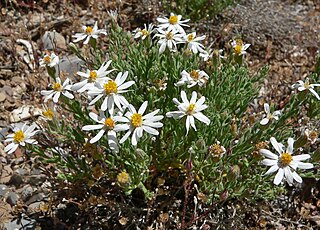
Chaetopappa is a genus of plants in the family Asteraceae which are known generally as leastdaisies.

Ericameria laricifolia is a North American species of flowering shrub in the daisy family known by the common name turpentine bush, or turpentine-brush. It is native to the southwestern United States and northern Mexico (Chihuahua).

Heterotheca sessiliflora is a species of flowering plant in the family Asteraceae known by the common name sessileflower false goldenaster. It is native to California, Sonora, and Baja California.

Chaetopappa ericoides is a species of flowering plant in the family Asteraceae known by the common names rose heath and heath-leaved chaetopappa. It is native to the southwestern and western Great Plains regions of the United States, plus northern Mexico. It is found in California, Nevada, Arizona, Utah, New Mexico, Colorado, Wyoming, Texas, Oklahoma, Kansas, Nebraska, Chihuahua, Coahuila, Sonora, Durango, Zacatecas, San Luis Potosí, and Nuevo León.
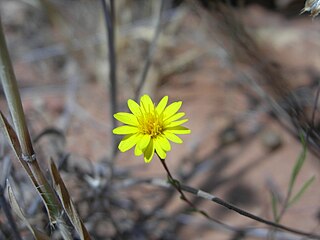
Pentachaeta aurea is a species of flowering plant in the aster family known by the common names golden-rayed pentachaeta, golden chaetopappa, and golden leastdaisy. It is native to southern California, where it grows in the San Gabriel and San Bernardino Mountains and the Peninsular Ranges, and northern Baja California. It is an annual herb with a hairy stem reaching a maximum height near 36 centimeters from a slender taproot. The narrow linear leaves are up to 5 centimeters long but only a few millimeters wide and may be very hairy. The inflorescence is a solitary flower head, with up to 22 heads per plant. The flower head bears many yellow, brownish, or whitish ray florets 3 to 12 millimeters long, and has a center of many five-lobed yellow to reddish disc florets. The fruit is an achene tipped with a pappus of bristles.

Dittrichia viscosa, also known as false yellowhead, woody fleabane, sticky fleabane and yellow fleabane, is a flowering plant in the daisy family.

Petrophile pulchella, commonly known as conesticks, is a common shrub of the family Proteaceae and is found in eastern Australia. The leaves are divided with needle-shaped but soft pinnae, the flowers silky-hairy, cream-coloured and arranged in oval heads and the fruit are arranged in oval heads. Conesticks grows on shallow sandstone soils, often in open forest or heathlands near the coast. It is also occasionally seen on the adjacent ranges.
Chaetopappa hersheyi is a rare perennial plant species of plant called Hershey's cliff daisy, in the sunflower family. The epithet "hersheyi" honors the plant's discoverer, Alfred Hershey who collected it in 1944. It was formally described by Sidney Fay Blake in 1946.
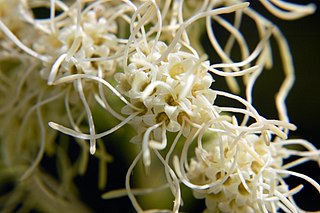
Brickellia eupatorioides, or false boneset, is a North American species of flowering plants in the family Asteraceae. It is widespread in Mexico from Chihuahua to Oaxaca, and in all regions of the contiguous United States except New England, New York, and the West Coast.
Chaetopappa asteroides, called the tiny lazy daisy, or Arkansas leastdaisy, is a North American species of plants in the family Asteraceae. It is native to the southern Great Plains of the United States and also to northeastern Mexico.
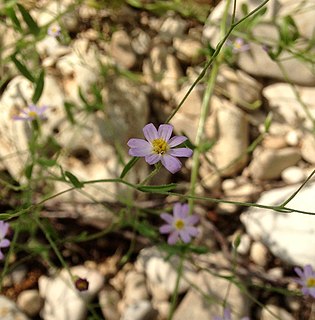
Chaetopappa bellidifolia , called the Edwards lazy daisy, or whiteray leastdaisy, is a North American species of plants in the family Asteraceae. It has been found only in central Texas, largely in the Edwards Plateau.
Chaetopappa bellioides, called the pretty lazy daisy, or manyflower leastdaisy, is a North American species of plants in the family Asteraceae. It native to northern Mexico and to the Rio Grande Valley in western and southern Texas.
Chaetopappa effusa, called the spreading lazy daisy, or spreading leastdaisy, is a North American species of plants in the family Asteraceae. It has been found only in Texas, largely on the Edwards Plateau.
Chaetopappa imberbis, called the awnless lazy daisy, or awnless leastdaisy, is a North American species of plants in the family Asteraceae. It has been found only in south-central Texas.
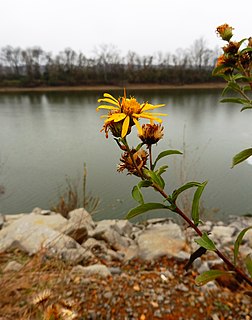
Heterotheca camporum, known by the common name lemonyellow false goldenaster, is a North American species of flowering plant in the family Asteraceae. It is found only in the central United States, primarily the Ozarks, the Cumberland Plateau, and the middle Mississippi Valley. There are reports of additional populations in the Northeast, the Southeast, and in the Great Lakes region, but these appear to be waifs or naturalizations.

Symphyotrichum eulae is a species of flowering plant in the family Asteraceae endemic to Texas. Commonly known as Eula's aster, it is a perennial, herbaceous plant that may reach 5 to 150 centimeters tall. Its flowers have white to lavender-pink ray florets and yellow then red to brown disk florets. It was named for Eula Whitehouse, American botanist, botanical illustrator, and plant collector.













